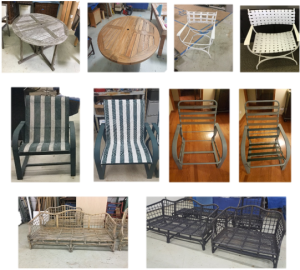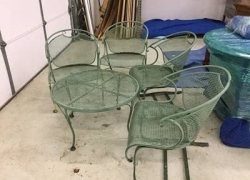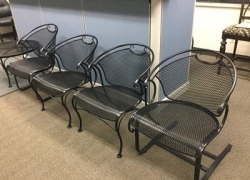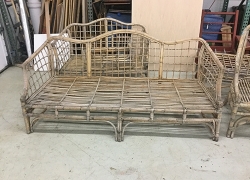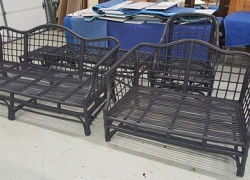Refinishing Outdoor Wood Furniture
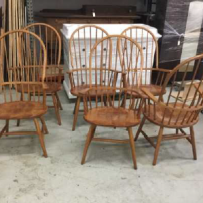
Outdoor furniture adds functionality and comfort to any outdoor area and turns it into a great place to socialize, relax, and enjoy fresh air and natural beauty. Wood furniture, in particular, makes the best addition to an outdoor space – it is a natural product that blends in with the surroundings and brings a lot of charm and warmth to the ambience.
However beautiful and comfortable outdoor wooden furniture may be though, it is likely to lose much of its appeal within just a couple of years out in the elements. Rain, snow, ice, intense sunlight, extreme heat and freezing cold take a big toll on outdoor furniture, marring its surface and stealing its luster. Yet, you don’t need to replace your wood patio table or bench just because it is sun-bleached or a bit grimy – as long as a furniture piece is in good structural shape, you can easily restore its beauty and shine. All you need to do is refinish your weathered piece.
Refinishing outdoor wood furniture may seem like a daunting task, but it is not as difficult as it sounds. You just need to know how to restore weathered wood furniture the right way:
Clean the Furniture Well
First things first, you need to give your outdoor furniture piece a thorough cleaning:
- Make a 50/50 mixture of dish soap and water and use a soft bristle brush to scrub the wood surface clean;
- Rinse thoroughly with clear water;
- If there are any stains remaining on the wood surface, use a specialized wood cleaner to remove them and rinse again;
- Let the furniture dry completely before proceeding.
It is also a good idea to hose down the furniture with a power washer or high pressure hose – this will remove not only dirt and debris, but flaking paint as well.
Remove the Old Finish
In order to refinish outdoor wood furniture, you need to remove its old finish first. Since outdoor pieces are exposed to the elements, their finish is often loosened and relatively easy to remove:
1) Strip the furniture. You can easily remove any flaking and loose paint or varnish by hosing down your furniture piece. Then, you can simply scrape the rest of the old finish off with a paint scraper. To completely strip the furniture and ensure a smooth and even surface, however, you will need a chemical stripper:
- Choose an appropriate wood stripper. You may want to use a thicker formula – a gel or paste as liquid strippers will run if applied to vertical surfaces. It is also advisable to opt for a product that is marked as “no cleanup” or “will wash away with water” – otherwise, you may need to apply a lacquer thinner to remove the leftover residue from the chemical stripper. Keep in mind though that: 1) “no cleanup” strippers may still leave a residue that will have to be sanded away and 2) although any residue from “washable” strippers can be removed by rinsing with water, the water may raise the grain of the wood, so that sanding will still be necessary;
- Use a medium-sized brush to apply a thick coat of the stripper evenly over the furniture surface;
- Let it soak for about half an hour, so that the stripper can soften and loosen the finish;
- Work with a round-edged putty knife or a plastic scraper to remove as much of the paint and varnish as possible (be careful not to gouge the wood). Use a soft brass brush to get into grooves and crevices;
- Follow up with medium grade steel wool, soaked in the stripper – this will help you easily remove any stubborn spots;
- When the old finish is entirely gone, clean the stripper from the wood (if necessary);
- Allow the piece to dry completely.
2) Sand the wood. Sanding will assure an even surface that will properly accept the new finish. Start with 120-grit sandpaper to remove any remaining finish and even out imperfections in the wood, then smooth the whole piece down with 220-grit sandpaper. Alternatively, you can work with an orbital sander and use sandpaper only for hard to reach areas. Either way, make sure you sand along the grain of the wood and be careful not to sand too deeply and damage your furniture. When ready, wipe all the surfaces with a tack cloth to clean off any dust from the sanding.
Good to remember:
- Make any necessary repairs before sanding and staining the furniture. Also, make sure you fix any cracks or holes (use wood filler) to produce a smooth surface as even small dents and cracks will show up clearly when the new finish is applied;
- Take safety precautions – Refinishing wood furniture is a messy job that may present considerable health hazards unless you take appropriate precautionary measures. You’re advised to work in a well-ventilated area, such as an open garage or a patio, and wear rubber gloves, safety glasses, and a dust mask to protect yourself from harmful chemicals, noxious fumes, dust, flying debris, and other risks. Never work near an open flame as stains and stripping chemicals can easily ignite. Also, don’t forget to put large drop cloth or tarp on the floor of your work area and cover any nearby items to prevent stains and facilitate cleaning after the job is complete.
Stain the Furniture
Staining outdoor wood furniture is an exciting process that allows for a lot of creativity and personalization – you will not only bring your weathered pieces back to life, but will be able to transform them into beautiful works of art that perfectly match your personal style and overall exterior décor. Just make sure you use an appropriate outdoor furniture stain and work carefully and patiently:
- Prime the surfaces, so that the paint adheres more uniformly and lasts longer;
- Test the paint on a small, inconspicuous area of the furniture to see how it looks;
- Apply a thin, even coat of stain all over the surfaces – use a foam roller or a staining pad for flat surfaces and a paintbrush for edges and corners;
- Wipe off any excess paint with a clean cloth and let the stain dry for the recommended period of time;
- Lightly sand the furniture to remove any residue from the paint and smooth the surfaces;
- Wipe with a tack cloth to remove any dust or debris;
- Repeat the process as necessary – you may need to apply multiple layers until you get the desired result. Just make sure you wait for the paint to dry completely before applying the next coat and lightly sand the wood between coats.
Seal the Paint
The final step in your outdoor wood furniture refinishing project is to protect the paint from the elements. When the final coat of stain is fully dry, wipe the furniture surfaces clean, and apply a thin layer of appropriate outdoor sealant. Wait for it to dry, sand the furniture with fine-grit sandpaper to make the surface smoother, remove any dust from the sanding with a new tack cloth, and apply a final layer of sealant to ensure the best possible protection to your furniture.
Let the wood cure for a couple of days before putting your refinished furniture back to use. Do not leave wet and freshly finished patio furniture outside to dry though – dirt and debris from the air may settle into the new furniture paint and result in unsightly specks. To prevent this, you need to keep your repainted furniture indoors – in a shed or garage – until it dries.
Bonus tips for refinishing outdoor wood furniture:
- If you don’t want to repaint your outdoor wood furniture, you can simply sand away the old finish and apply a clear sealant on top – this will result in a charming weathered look and will keep your patio furniture protected from the elements;
- If you have teak patio furniture, you can easily restore its color and luster by rubbing it with teak oil (after it has been thoroughly cleaned). You can also sand the piece to remove the dark patina, strip the worn out outer layers of the furniture, and reveal the golden-brown of the teak. Either way, it is a good idea to use a teak sealant to protect the wood from weathering.
Now that you know how to refinish outdoor wood furniture, you can decide if you’re up to the task or not – it’s very satisfying to bring your weathered pieces back to life yourself, but the process is laborious and time-consuming. It can be very complex too, especially if your patio furniture is more intricate or has sustained some kind of damage.
Wood furniture repair is better left to the professionals. At Furniture Medic by MasterCare Experts, we have the specialized equipment, rich experience, and technical know-how to complete the job in the safest, fastest, and most efficient way possible. So, if you’re in need of wood furniture restoration in the Carol Stream, IL area, do not hesitate to call us – our skilled craftsmen will effectively restore the natural beauty and strength of your worn out pieces.

